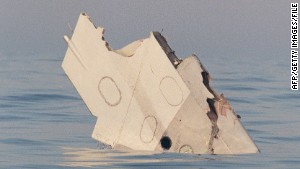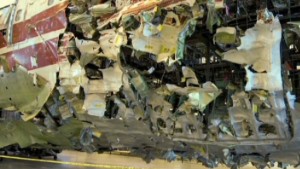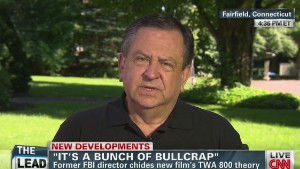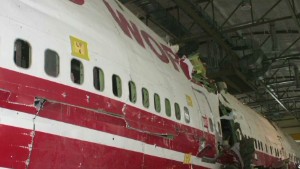Editor's note: Sylvia Adcock covered aviation safety and security for Newsday from 1996 until 2005. She is editor of NC State magazine, the alumni magazine of North Carolina State University in Raleigh.
(CNN) -- It wasn't long after TWA Flight 800 exploded off the coast of Long Island on a warm July evening in 1996 that the conspiracy theorists emerged. Seventeen years later, they're still here.
I haven't seen a new documentary that purports to repudiate the conclusions of the National Transportation Safety Board, which ruled that the crash of the 747 headed for Paris was caused by a center fuel tank explosion likely ignited by faulty wiring. But I do know that -- despite all the media attention the filmmakers are getting -- their essential claim that a missile hit the plane is not new.
And neither are aircraft fuel tank explosions. In fact, they were considered enough of a danger that the Federal Aviation Administration has put in place new regulations to prevent such events. And the FAA, heavily lobbied by airlines and aircraft manufacturers who want to keep their costs low, does not enact new regulations without reason.
 Sylvia Adcock
Sylvia Adcock When I covered the four-year investigation into TWA Flight 800 for Newsday, I spent hundreds of hours interviewing investigators, scientists and experts; I walked around inside the center fuel tank of a Boeing 747 (yes, it's that big) at a plant in Seattle; and I continued to cover the aftermath of the NTSB's final report that culminated in an FAA rule to make airlines pump inert gas into fuel tanks to prevent explosions.
I remember being surprised when I first learned of fuel-tank explosions on aircraft, particularly those designed with air-conditioning units below the center tank. At first it seemed unbelievable. But when an aircraft's fuel tank is nearly empty, as is often the case with the center tank, the heat from the air-conditioning packs underneath combined with ambient temperatures can create, well, what seems like a bomb on board.
 What caused TWA Flight 800 to crash?
What caused TWA Flight 800 to crash?  Investigator: Lies told on plane crash
Investigator: Lies told on plane crash  Investigator: New TWA theory is 'bull'
Investigator: New TWA theory is 'bull'  NTSB: Design flaw doomed TWA 800
NTSB: Design flaw doomed TWA 800 In 1990, the fuel tank of a Philippine Airlines plane exploded on the ground in Manila, killing eight people. In 2001, a Thai Airways International plane blew up on the ground in Bangkok when its center tank exploded.
And as recently as 2006, the wing tank of a Boeing 727 exploded on the ground in Bangalore, India.
In 2000, the FAA compiled a list of 26 fuel-tank explosions dating back to 1959.
I also remember the day l learned that the system that tells pilots how much fuel remains includes electrical components located inside the tank. Although aircraft wiring is made to be strong and durable, it is also subject to the effects of aging and abrasion -- so much so that short circuits can occur. On July 17, 1996, the conditions -- a volatile fuel-air mix of vapors in the center fuel tank heated to the point of being explosive, a likely short circuit in fuel-gauge wiring and 230 people on board -- came together with a tragic result.
I can't speak to the motives of the former investigators who are calling for a renewed investigation. But it is important to note that while a poster from the film on epix.com trumpets, "inside investigators finally break their silence," one of the key investigators featured testified about the NTSB's failings before the Senate Judiciary Committee in 1999. It would seem that if he had something more pertinent to say he would have said it long ago.
As for the missile theory, its main proponents were those eyewitnesses who reported seeing a streak of light in the sky on the night of the crash. That streak has been explained as the still-airborne fuselage of the Boeing 747 after the nose of the plane broke off and fell to earth -- and debris recovery patterns confirm this scenario. Metallurgical evidence showed that the fuel tank, the main structural component between the wings, exploded from the inside, with no evidence of a puncture or outside entry.
The filmmakers say they have new radar evidence. I don't know why it hasn't surfaced before now, or how it will contradict the physical evidence that shows the fuel tank exploded from the inside. I do know that when the process turns to fault-finding in aviation accidents, there are many competing interests with a stake in the game -- the pilots' union, aircraft manufacturers and airlines, all with lawyers ready to battle their side.
When I covered aviation safety, it seemed that the NTSB was the only entity with no conflicts of interest. Even the media want a good story -- and what better story than a missile and cover-up? I imagine the same can be said of people who want to sell an idea for a documentary. Fuel-tank explosions and exposed wiring just aren't that sexy.
Conspiracy theories about TWA Flight 800 are a bit like 17-year cicadas. Except they seem to emerge a bit more often.
Follow us on Twitter @CNNOpinion.
Join us on Facebook/CNNOpinion.
{ 0 comments... read them below or add one }
Post a Comment